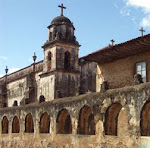.jpg) By Tracy Novinger
By Tracy Novinger[Double click on an image for larger view.]
There does not seem to be any culture in the world that burlesques death as does Mexico. In Mexican folk art, death is seen as the other half of life and is a common motif. In fact, representations of skulls and skeletons are so common to the artist’s and artisan’s world that they have practically become synonymous with Mexican culture.
Europeans and Americans hate to be reminded of the brevity of life. However, the perception of death is a different and complex blend of indigenous and Spanish influences in Mexico. For most Mexicans, the psychic burden of life is in its anguish—the exposure, with insufficient defense, to danger and to evil. Mexico’s Indians perceived (and must still perceive) life as suffering, where the submissive and weak are permanent victims of the strong. Torture was felt as something very personal, and the martyrdom that man inflicts on man is a profound experience in the Indian’s sentimental world. Consequently and in this context, over centuries, indigenous and mestizo artists have passionately depicted the crucified Christ’s suffering and bleeding in a thousand terrifying ways, creating a Mexican colonial Christ of specifically Mexican sensibility.* Moreover, images of skulls and skeletons are found abundantly in Mexico’s pre-Columbian indigenous a.JPG) rtifacts.
rtifacts.
More recently, however, since the late 19th century, motifs representing death have frequently been used in arts and crafts in a more light-hearted, mocking manner, perhaps as a way of coping with an otherwise unbearable concept. One uniquely Mexican creation to emerge has been the Catrinas. At first glance, these figures of skeletons dressed in outrageous clothing put off and shock many. The skeleton Catrinas originated with Jose Guadalupe Posada (1852-1913), who published scathingly humorous portraits of society in Mexico City; anyone was fair game. His Catrinas were dressed in elegant European finery, adorned with wide-brimmed, feathered hats. This image parodied wealthy Mexican women of the time, who overdressed amid the poverty of the majority of Mexicans. Posada’s Catrinas, in fact, depict death as the great equalizer: all persons in the end are reduced to bones, rich and poor, powerful and powerless alike. Mexico’s lighthearted depiction of death serves to remind us of the inevitable for all. The Catrinas are one of the most whimsical art forms Mexico has to offer.
There does not seem to be any culture in the world that burlesques death as does Mexico. In Mexican folk art, death is seen as the other half of life and is a common motif. In fact, representations of skulls and skeletons are so common to the artist’s and artisan’s world that they have practically become synonymous with Mexican culture.
Europeans and Americans hate to be reminded of the brevity of life. However, the perception of death is a different and complex blend of indigenous and Spanish influences in Mexico. For most Mexicans, the psychic burden of life is in its anguish—the exposure, with insufficient defense, to danger and to evil. Mexico’s Indians perceived (and must still perceive) life as suffering, where the submissive and weak are permanent victims of the strong. Torture was felt as something very personal, and the martyrdom that man inflicts on man is a profound experience in the Indian’s sentimental world. Consequently and in this context, over centuries, indigenous and mestizo artists have passionately depicted the crucified Christ’s suffering and bleeding in a thousand terrifying ways, creating a Mexican colonial Christ of specifically Mexican sensibility.* Moreover, images of skulls and skeletons are found abundantly in Mexico’s pre-Columbian indigenous a
.JPG) rtifacts.
rtifacts.More recently, however, since the late 19th century, motifs representing death have frequently been used in arts and crafts in a more light-hearted, mocking manner, perhaps as a way of coping with an otherwise unbearable concept. One uniquely Mexican creation to emerge has been the Catrinas. At first glance, these figures of skeletons dressed in outrageous clothing put off and shock many. The skeleton Catrinas originated with Jose Guadalupe Posada (1852-1913), who published scathingly humorous portraits of society in Mexico City; anyone was fair game. His Catrinas were dressed in elegant European finery, adorned with wide-brimmed, feathered hats. This image parodied wealthy Mexican women of the time, who overdressed amid the poverty of the majority of Mexicans. Posada’s Catrinas, in fact, depict death as the great equalizer: all persons in the end are reduced to bones, rich and poor, powerful and powerless alike. Mexico’s lighthearted depiction of death serves to remind us of the inevitable for all. The Catrinas are one of the most whimsical art forms Mexico has to offer.
*Westheim, Paul. La Calavera, fondo de Cultura Económica (Breviarios), México, 1996. En: Artes de México, Revista Libro Número 67, Primera Edición, 2003. Fundada en 1953 por Miguel Salas Anzures y Vicente Rojo. Pp 80-81 Westheim, Paul. La Calavera, fondo de Cultura Económica (Breviarios), México, 1996. En: Artes de México, Revista Libro Número 67, Primera Edición, 2003. Fundada en 1953 por Miguel Salas Anzures y Vicente Rojo, pp 80-81.
All photos were taken in Patzcuaro, Michoacan, Mexico at time of Noche de Muertos/Night of the Dead celebrations.
.JPG)
.jpg)





.JPG)
.JPG)
.jpg)
.jpg)
.JPG)
.JPG)
.JPG)
.JPG)
.jpg)
.JPG)

.jpg)
.jpg)



















